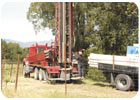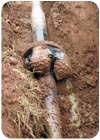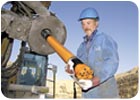
This rig is owned by Ed Fisch of Fisch Brothers Drilling from Sebastopol, Calif. The company will drill with both air and mud because of the very diverse mountain and valley formations. They typically drill 7 3⁄4-inch to 8 3⁄4-inch holes but will drill as large as 12 1⁄4 inches. They typically case the hole with 5- or 6-inch PVC, and must pack the hole with sand because the silt in the valley is like talc and would clog the pump filter.
There are as many ways and reasons to put a hole in the ground as there are variations in geology. Although many drilling contractors will never use all the tools that are available, it often is interesting to see how our colleagues working in other applications do their jobs. And maybe you can see how a product or efficiency can make a difference in your business.
A superintendent from a major construction company told me recently he had hired three operators before finding someone who could run his crawler drill competently. Turns out he came from the Texas oil patch.

A 14-inch, five-cone split set hole opener. Its random cutting structure allows all five cones to touch the hole face for greater contact and increased penetration.
The owner of a prominent contract drill and blast company - which used 600 bits last year - recently compared the components of the drill to an athlete. To shorten the analogy, the drill is the athlete's body, which can come in different shapes and sizes needed for the application, but the bit is the heart, and is critical to the overall performance of every drilling operation.
The tooling is not just an attachment, such as you have with other types of heavy equipment. Without the tool, there is no hole. And everything we do is affected by the hole - from the water we drink, to the oil and coal to power our homes and equipment, to the aggregates and minerals used to make the roads and fabricate more equipment.

An overburden casing system.
Air or mud? Tricone or DTH hammer? Horizontal or vertical? How many of these drilling methods are required for your applications?
I recently had a conversation with a contractor who drills in California's grape-growing mountains and valleys of Sonoma County. The geology varies from chert to sandstones to volcanics in the mountains, and sands and silts the consistency of talc in the valleys.
Each day can be a totally different hole. He drills with mud 60 percent of the time and air the other 40 percent. His rig is a TH60 because of its versatility for mountain work and mud and air drilling capability, but he has to be ready to go from DTH hammer to tricone on any hole.

The bit is critical to the overall performance of every drilling operation.
Just as bits are designed to best penetrate the rock formation, drillers have choices for down-the-hole hammers. There are many options for hammers today, and the tool should be selected based on the driller's need for performance.
Hammers can be selected for speed (higher penetration rates), efficiency (less dollars means lower performance), serviceability (valve or valveless technology) or local drilling environment (varying formations and ground conditions).
Typically, valveless hammers cost less and are easier and less expensive to maintain, but don't offer the highest rate of penetration.
There are many hammer options for the driller, even within a size class. And the benefits differ based on the situation and the desired outcome for the application. It is important to look at the big picture, and that equates to overall productivity and cost per hour.
Horizontal drilling was booming a few years ago, and because the telecom industry that fueled the boom took a dip, so did the business. Those companies that survived are stronger, and they have sought out equipment that can maximize cost per footage.
Pilot bits and hole openers have gained market attention because of the increased footage they offer. And traditionally where tricone bits were used to fabricate hole openers, split set products are winning over drillers because of their longer life and decreased cost per foot.

A 5-inch DTH hammer and bit being used at an open-pit copper mine.
The product that eventually will run through a horizontal hole must have plenty of room to be pulled through that hole. Therefore, the hole must be a minimum of 25 percent larger than the product that will be installed. A good rule of thumb is product size times 1.5 to determine the final hole size.
Casing advanced drilling is used today in more and more applications, but remains the best solution when starting a straight hole in overburden or loose soil applications. If drillers are not using overburden products, this could be a good market niche to expand into without the large capital investment of a new drill rig.
When it comes down to the bottom line a driller looks to it increase market opportunity without over extending himself. A drilling contractor recently told me he wanted to grow his business and was close to needing a new rig, but that he needs a little more diversification and new business to take the jump.
Growing can come from increasing your market base, but sometimes the little boost may come in the increased efficiency in the work already being done. Knowing your tool options can give you that edge.
ND

Report Abusive Comment